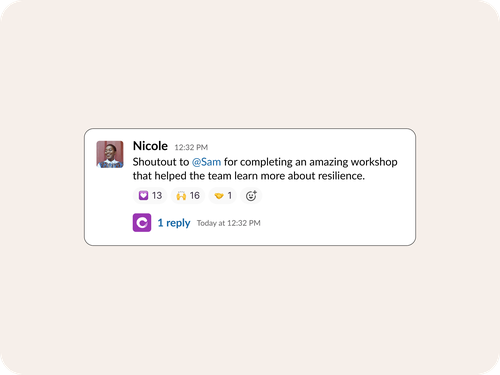
Your guide to managing and growing a high-performing team

There’s more to building high-performing teams than putting a bunch of smart, talented, and highly skilled individuals together in a room. Exceptional performance also calls for communication, alignment, openness, trust, and a growth mindset – all fostered by a strong leader.
Want to lead your team to excel? There are strategies and tips you can use to get to know your people, guide them to success, and push them to do their best. In this article, we’ll share five ways managers can build high-performing teams.
1. Set specific and achievable goals
Every high-performing team needs clear, achievable team and individual goals. You’ll want to make goal-setting a collaborative process with your employees, but as a manager, it’s your responsibility to align each direct report’s individual goals with larger organizational objectives. Shared targets improve team alignment and collaboration while ensuring every employee understands how their contributions impact your organization’s success.
At Culture Amp, we recommend managers use the SMART goal framework with their teams to establish specific, measurable, achievable, relevant, and time-bound goals. This framework gives your employees clarity while making it easy for you to monitor progress and provide support as their manager.
2. Communicate clearly and often
Ongoing communication is the key to maintaining a high-performing team. Schedule and conduct regular 1-on-1 meetings with every direct report on your team. These ongoing conversations are an opportunity to:
- Get to know your employees personally
- Check-in on employee wellbeing
- Discuss any personal and professional issues
- Give and receive feedback
- Review goal progress
- Identify and remove roadblocks
- Talk about developmental goals
- Answer any questions or concerns
- And more
Just remember that every employee is different. Some will want to touch base with you frequently, while others may prefer to work more autonomously. At the beginning of your work relationship, discuss expectations and determine a 1-on-1 meeting cadence that works for both of you.
Done right, 1-on-1s can help you create a positive and supportive work environment. When employees trust that you want the best for them, they will feel more comfortable raising challenging topics, taking risks, and trying new things. Clear communication keeps you all on the same page and ensures employees know exactly what’s expected of them.
3. Share ongoing feedback
While most managers have no problem offering positive feedback, many struggle to share developmental and constructive feedback on an ongoing basis. It may feel awkward talking with employees about how they can improve, but this type of feedback is often the most valuable. It gives individuals specific, actionable guidance that can help drive their professional growth.
Ask your team to share feedback with each other as well. By building a team culture that embraces ongoing feedback, you’ll encourage your team to celebrate each other’s wins and help each other grow. With a tool like Culture Amp, employees can proactively request feedback from colleagues whenever they want, allowing them to get instant feedback after an important project, a cross-functional assignment, or a high-visibility presentation. This makes giving and receiving feedback a team effort and helps every employee take responsibility for their own and their peers’ growth.
4. Recognize hard work
Celebrate wins, big and small! Regular employee recognition does wonders for boosting morale and ensures everyone on your team feels seen and appreciated, no matter how junior or senior their role is.
Recognition comes in many forms, so consider mixing up how you call out employee accomplishments. Here are a few ways to recognize employees:
- Written: This can be via your company’s internal messaging system (in public or private channels), over email, or in team reports.
- Verbal: You might choose to shout out an employee privately in ongoing 1-on-1s or publicly in a team or department meeting.
- Financial: If you have the means, you can reward your employee with a gift card or bonus to show your and the company’s thanks.
- Formal: Whether or not you’re able to financially reward employees, nominating them for Employee of the Month or for company value-based awards honors the contributions they’ve made to your business.
When you recognize employees, ensure the recognition doesn’t only happen privately. Celebrating employee wins publicly raises the visibility of your employees’ achievements, allowing them to feel seen and appreciated by the organization at large.
5. Develop your talent
Lastly, look to the future. While it’s great that your employees are strong performers in the present, as their manager, it’s your job to set them up with the hard and soft skills and necessary resources to thrive as they grow and take on new roles.
Investing in your talent can also improve retention. In fact, Culture Amp research found that employees who don’t feel they have access to clear development opportunities are 41% more likely to leave their current company.
In addition to encouraging your employees to adopt a growth mindset, push them to embrace continuous learning with an individual development plan (IDP). IDPs identify individual strengths, weaknesses, and aspirations to create an actionable plan designed to help employees reach their professional goals. Using IDPs and sharing continuous feedback with your employees can inspire and motivate them to achieve their goals and grow their careers within your organization.
Be the manager you wish you had
Every manager is in a unique position to support their team. By investing in and coaching employees to be the best they can be, managers help drive team growth and performance. From your unique vantage point as a manager, you can share meaningful feedback and make improvements that drive communication, collaboration, morale, retention, and, ultimately, productivity for your employees.
For even more insights and best practices into how to build off employee strengths and lead your team to success, download our guide, The manager’s guide to supporting high-performing teams.





